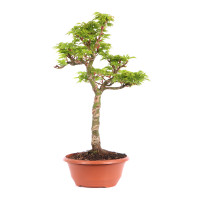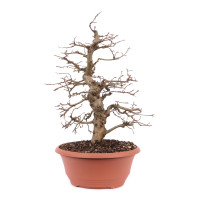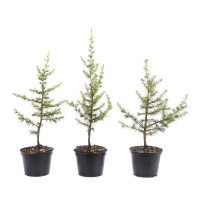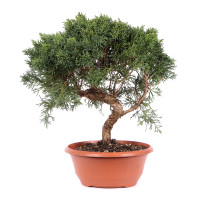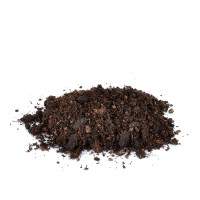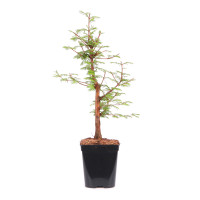- Order number: 1943-P-24-3928
- Height: 30 cm (incl. pot)
- Foliage: evergreen
- Bonsai Pot: plastic pot
- Age: ca. 13 years
- Importjahr: 2024
- Origin: Japan
Juniperus chinensis 'Kishu' - Chinese Juniper 'Kishu'
General information:
The Chinese Juniper grows in its native habitat (China, Mongolia and Japan) as a shrub or tree up to 20 meters high. The habit is very diverse and influenced by the extreme locations on the coast and in the mountains. The dark brown bark flakes off in narrow strips over time and then becomes reddish-brown and smooth. Over time, many cultivated forms of the Chinese Juniper have developed and it can be found in many gardens. Unfortunately, the Chinese Juniper is an intermediate host of pear rust. For this reason, it is often removed from gardens today.
Care as a bonsai:
The Chinese Juniper is the best-known and most popular conifer for bonsai design alongside the Scots pine. The fine evergreen foliage, the flexibility of the wood and the general robustness make the plants an ideal starting material for bonsai design. In Japan, you can also find ancient and bizarrely grown junipers in the wild. These characteristics offer almost unlimited possibilities for rearranging the plant's greenery and creating interesting deadwood areas. The juniper can also tolerate massive interventions as long as it is given time to regenerate. A sunny spot outdoors in summer is very important for healthy development. In a shady location, the coloration of the needles suffers and the shoots become long and unsightly. A very bright but sheltered spot is also essential in winter. The reddish-brown discoloration of the needles in winter is normal. In spring, when it gets warmer, the needles turn green again. Even if abundant watering is required in the summer months, waterlogging must be avoided at all costs. The Chinese juniper can tolerate short-term drought without damage. Shaping with topiary and wires is carried out during the dormant period from November to March. Repotting is carried out from August to September in soil that is well permeable to air and water. The only animal pests we have encountered on junipers are aphids and spider mites. However, these can be quickly eliminated using commercially available plant protection products. An optimal location, attentive care and sufficient nutrition are generally the best preventative plant protection measures.
Special features of the variety:
The 'Kishu' variety originates from the historic Japanese province of the same name (now Wakayama Prefecture). Due to its compact and dense growth, the Chinese Juniper 'Kishu' is very suitable for bonsai cultivation. The small dark green foliage also enables very fine and differentiated bonsai designs, making it particularly popular not only in Japan.
























